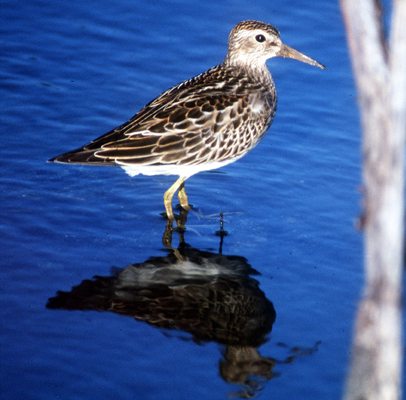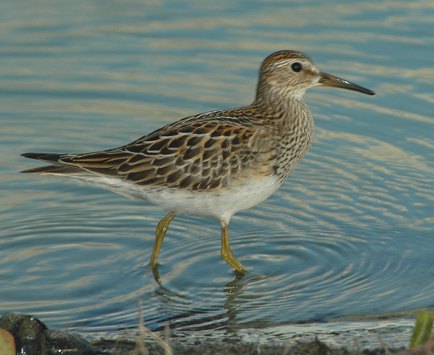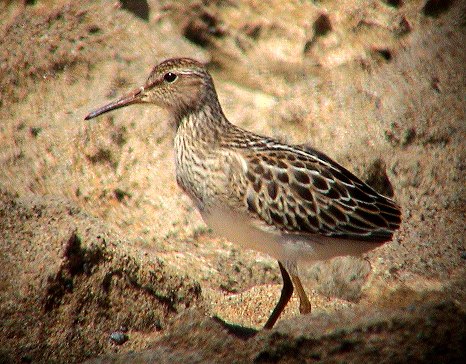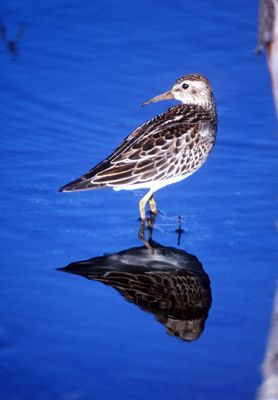|
Pectoral Sandpiper Calidris melanotos Playero Pectoral,
|
 |
|
Photo: B. Hallett
|
|
Pectoral Sandpiper Calidris melanotos Playero Pectoral,
|
 |
|
Photo: B. Hallett
|
|
IDENTIFICATION: A yellow-legged, medium-sized shorebird with a sharp boundary between dark breast and light belly. Length: 19 cm.; weight: males 81 g., females 71 g. VOICE: A hoarse "chirrup." Audio (M. Oberle). HABITAT: Feeds along edges of freshwater wetlands, on mats of algae, and in moist, dense grasslands. HABITS: The Pectoral Sandpiper is the champion migrant of the sandpiper world. Some birds that breed in the western Russian Arctic migrate east across Siberia and through Alaska to winter grounds in southern South America and then back in the spring: a round trip of 30,000 km. On migration individual birds defend temporary feeding territories, as they forage in freshwater wetlands. The Pectoral Sandpiper feeds on fly larvae, beetles, spiders, snails, crickets and grasshoppers by plucking prey off the surface. On the breeding grounds in the far North, males stake out a territory by flying at very slow speeds, low over the tundra, and inflating a special throat pouch. They make a deep, hooting noise as they advertise their presence. In contrast to many other sandpipers, the female builds the nest scrape alone on the male’s territory. The male will mate with other females who enter his territory. Shortly after the female begins to incubate the four eggs, the male abandons her and migrates south. After a 21-23 day incubation period, the chicks hatch and immediately leave the nest to forage under the female’s protection. The young birds depart for the long migration south about 4-6 weeks after hatching. STATUS AND CONSERVATION: An uncommon fall migrant. The Pectoral Sandpiper was far more common during the 19th Century, but was heavily impacted by market hunting. Loss of wetland habitat at migration stopovers and on winter grounds may be an increasing threat. RANGE: Breeds on the Arctic tundra from western Russia, across Siberia to coastal Alaska and northern Canada. Most birds winter in southern South America. TAXONOMY: CHARADRIIFORMES; SCOLOPACIDAE; Scolopacinae |
 |
|
Photo: G. Beaton
|
 |
|
Breeding plumage - Photo: G. Beaton
|
 |
|
Photo: R. Rodríguez Mojica
|
 |
|
Photo: B. Hallett
|
|
References Alerstam, T., G. A. Gudmundsson, M. Green, and A. Hedenstrom. 2001. Migration along orthodromic sun compass routes by Arctic birds. Science 291:300-303. Bent, A.C. 1927. Life histories of North American shore birds, part 1. Smithsonian Instit. U.S. National Museum Bull. 142. (Reprinted by Dover Press, NY, 1962). Collazo, J.A., B.A. Harrington, J. Grear, and J.A. Colón. 1995. Abundance and distribution of shorebirds at the Cabo Rojo salt flats, Puerto Rico. J. Field Ornithol. 66:424-438. del Hoyo, J., A. Elliott, and J. Sargatal, eds. 1996. Handbook of Birds of the World, Vol. 3. Hoatzin to Auks. Lynx Edicions, Barcelona. Grear, J. and Collazo, J. A. 1999. Habitat use by migrant shorebirds in a tropical salt flat system. Vida Silvestre Neotropical 7(1):15-22. Hayman, P., J. Marchant, and T. Prater. 1986. Shorebirds: an identification guide. Houghton Mifflin, Boston. Holmes, R.T. and F.A. Pitelka. 1998. Pectoral Sandpiper (Calidris melanotos). No. 348 in The birds of North America (A. Poole and F. Gill, eds.). The Birds of North America, Inc., Philadelphia, PA. Paulson, D. 1993. Shorebirds of the Pacific Northwest. Univ Washington, Seattle. Raffaele, H.A. 1989. A guide to the birds of Puerto Rico and the Virgin Islands. Princeton. Raffaele, H.A. 1989. Una guía a las aves de Puerto Rico y las Islas Vírgenes. Publishing Resources, Inc., Santurce, PR. Raffaele, H.A., J.W. Wiley, O.H. Garrido, A.R. Keith, and J.I. Raffaele. 1998. Guide to the birds of the West Indies. Princeton. Wunderle, J.M., Jr., R.B. Waide, and J. Fernández. 1989. Seasonal abundance of shorebirds in the Jobos estuary in southern Puerto Rico. J. Field Ornithol. 60:329-339. Linking Migratory Shorebird Habitats: The Power of Stable Isotopes:
Pectoral Sandpiper, Spanish text Next related species in taxonomic order Previous related species in taxonomic order |